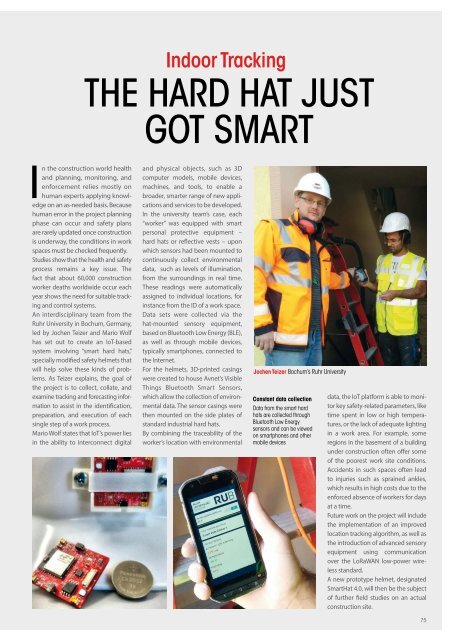Smart Industry 1/2018
Smart Industry 1/2018 - The IoT Business Magazine - powered by Avnet Silica
Smart Industry 1/2018 - The IoT Business Magazine - powered by Avnet Silica
You also want an ePaper? Increase the reach of your titles
YUMPU automatically turns print PDFs into web optimized ePapers that Google loves.
Indoor Tracking<br />
THE HARD HAT JUST<br />
GOT SMART<br />
In the construction world health<br />
and planning, monitoring, and<br />
enforcement relies mostly on<br />
human experts applying knowledge<br />
on an as-needed basis. Because<br />
human error in the project planning<br />
phase can occur and safety plans<br />
are rarely updated once construction<br />
is underway, the conditions in work<br />
spaces must be checked frequently.<br />
Studies show that the health and safety<br />
process remains a key issue. The<br />
fact that about 60,000 construction<br />
worker deaths worldwide occur each<br />
year shows the need for suitable tracking<br />
and control systems.<br />
An interdisciplinary team from the<br />
Ruhr University in Bochum, Germany,<br />
led by Jochen Teizer and Mario Wolf<br />
has set out to create an IoT-based<br />
system involving “smart hard hats,”<br />
specially modified safety helmets that<br />
will help solve these kinds of problems.<br />
As Teizer explains, the goal of<br />
the project is to collect, collate, and<br />
examine tracking and forecasting information<br />
to assist in the identification,<br />
preparation, and execution of each<br />
single step of a work process.<br />
Mario Wolf states that IoT’s power lies<br />
in the ability to interconnect digital<br />
and physical objects, such as 3D<br />
computer models, mobile devices,<br />
machines, and tools, to enable a<br />
broader, smarter range of new applications<br />
and services to be developed.<br />
In the university team’s case, each<br />
“worker” was equipped with smart<br />
personal protective equipment –<br />
hard hats or reflective vests – upon<br />
which sensors had been mounted to<br />
continuously collect environmental<br />
data, such as levels of illumination,<br />
from the surroundings in real time.<br />
These readings were automatically<br />
assigned to individual locations, for<br />
instance from the ID of a work space.<br />
Data sets were collected via the<br />
hat-mounted sensory equipment,<br />
based on Bluetooth Low Energy (BLE),<br />
as well as through mobile devices,<br />
typically smartphones, connected to<br />
the Internet.<br />
For the helmets, 3D-printed casings<br />
were created to house Avnet’s Visible<br />
Things Bluetooth <strong>Smart</strong> Sensors,<br />
which allow the collection of environmental<br />
data. The sensor casings were<br />
then mounted on the side plates of<br />
standard industrial hard hats.<br />
By combining the traceability of the<br />
worker’s location with environmental<br />
Jochen Teizer Bochum’s Ruhr University<br />
Constant data collection<br />
Data from the smart hard<br />
hats are collected through<br />
Bluetooth Low Energy<br />
sensors and can be viewed<br />
on smartphones and other<br />
mobile devices<br />
data, the IoT platform is able to monitor<br />
key safety-related parameters, like<br />
time spent in low or high temperatures,<br />
or the lack of adequate lighting<br />
in a work area. For example, some<br />
regions in the basement of a building<br />
under construction often offer some<br />
of the poorest work site conditions.<br />
Accidents in such spaces often lead<br />
to injuries such as sprained ankles,<br />
which results in high costs due to the<br />
enforced absence of workers for days<br />
at a time.<br />
Future work on the project will include<br />
the implementation of an improved<br />
location tracking algorithm, as well as<br />
the introduction of advanced sensory<br />
equipment using communication<br />
over the LoRaWAN low-power wireless<br />
standard.<br />
A new prototype helmet, designated<br />
<strong>Smart</strong>Hat 4.0, will then be the subject<br />
of further field studies on an actual<br />
construction site.<br />
75
















